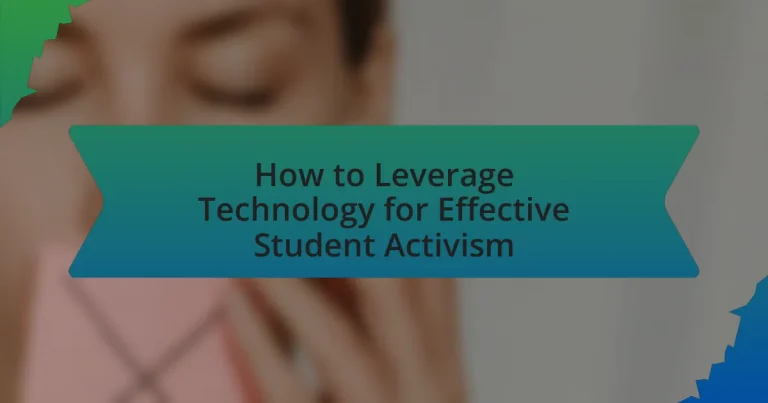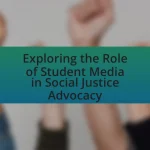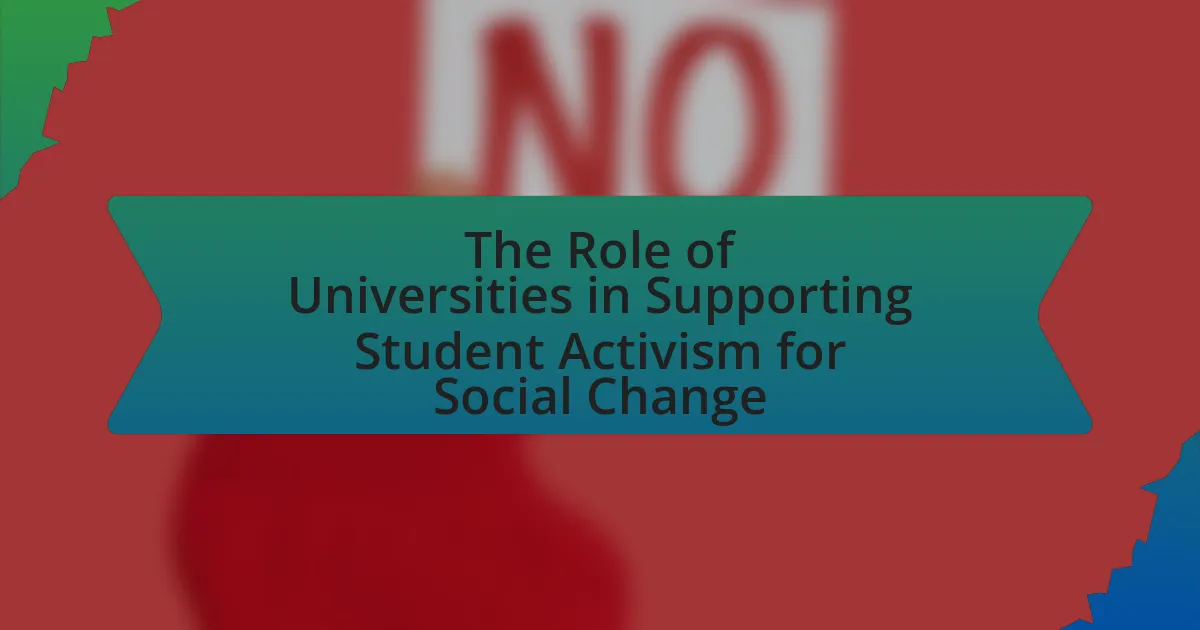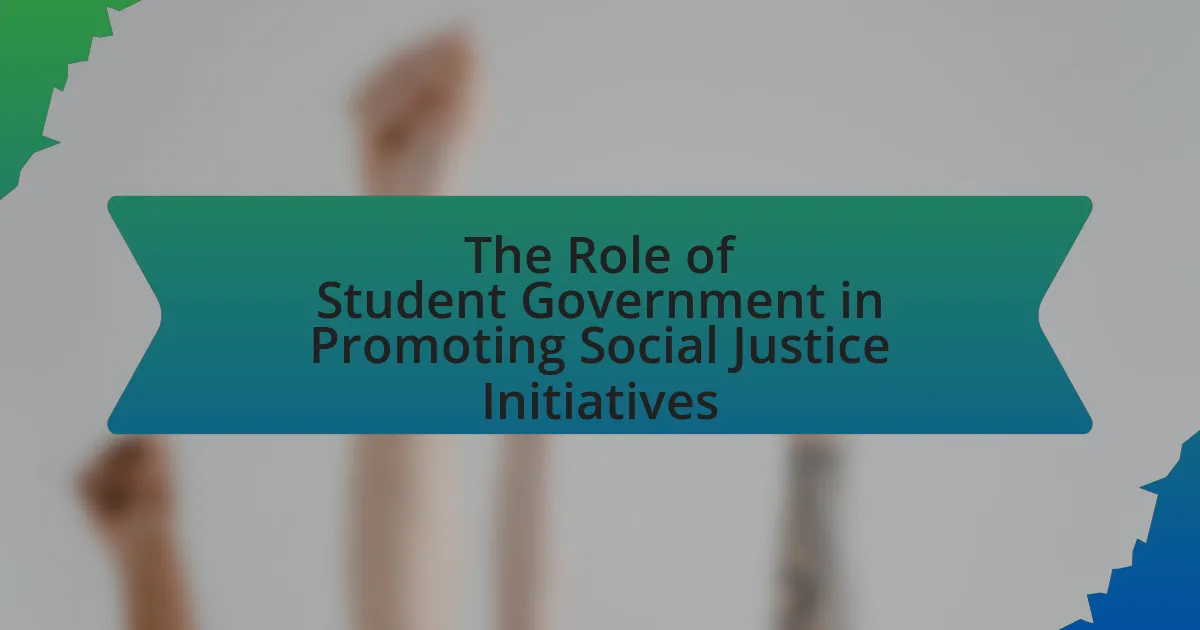Student activism involves organized efforts by students to advocate for social, political, or environmental change, often utilizing protests and campaigns to influence policy and raise awareness. Technology plays a pivotal role in enhancing these efforts by facilitating communication, mobilization, and information dissemination through platforms like social media, online petitions, and crowdfunding sites. The article explores how technology has transformed the landscape of student activism, the tools commonly used, and strategies for effective engagement, while also addressing challenges such as misinformation and digital privacy. Additionally, it provides practical tips for students to leverage technology in their activism, ensuring their initiatives are impactful and sustainable.
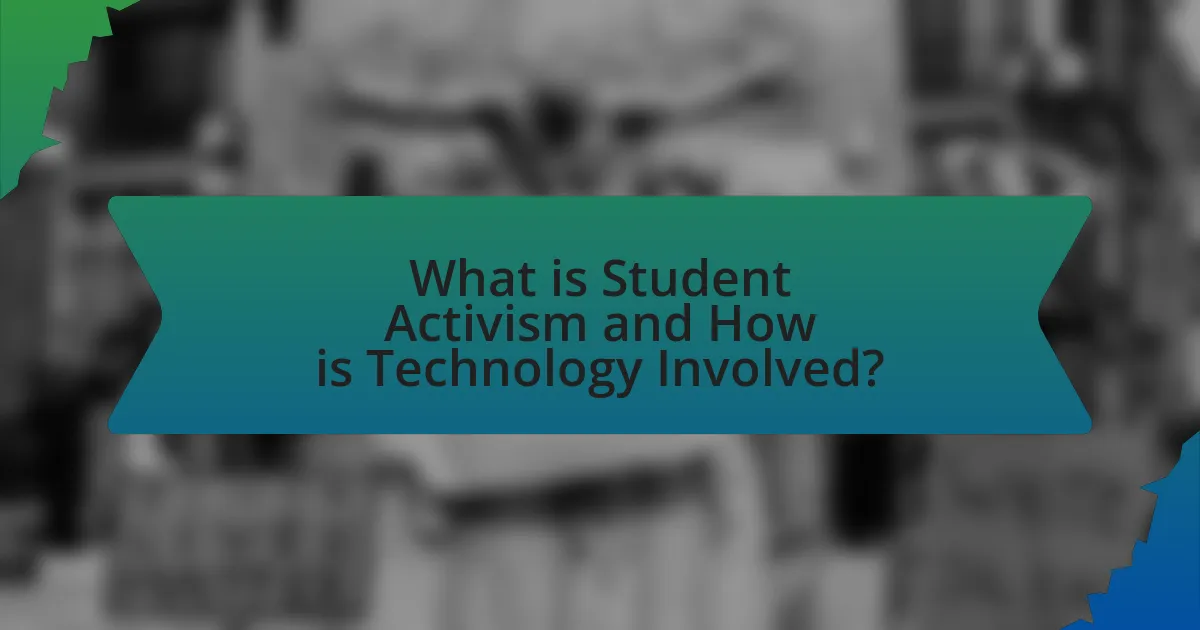
What is Student Activism and How is Technology Involved?
Student activism refers to the organized efforts by students to advocate for social, political, or environmental change. This form of activism often involves protests, campaigns, and initiatives aimed at influencing policy or raising awareness about specific issues. Technology plays a crucial role in student activism by facilitating communication, mobilization, and information dissemination. For instance, social media platforms like Twitter and Instagram enable students to share their messages widely and organize events quickly, as evidenced by movements such as the March for Our Lives, which utilized these platforms to rally support for gun control. Additionally, online petitions and crowdfunding sites empower students to gather resources and support for their causes, demonstrating the significant impact of technology in enhancing the effectiveness of student activism.
How has technology changed the landscape of student activism?
Technology has significantly transformed student activism by enhancing communication, mobilization, and awareness. Digital platforms such as social media enable students to organize protests, share information, and rally support quickly and effectively, reaching a global audience. For instance, the #BlackLivesMatter movement gained momentum through Twitter and Instagram, illustrating how technology can amplify voices and foster solidarity among diverse groups. Additionally, tools like online petitions and crowdfunding have made it easier for students to advocate for causes and secure funding for initiatives, demonstrating the practical impact of technology on activism.
What technological tools are most commonly used in student activism?
Social media platforms, messaging apps, and online petition tools are the most commonly used technological tools in student activism. Social media platforms like Twitter, Facebook, and Instagram enable students to share information rapidly, mobilize support, and raise awareness about issues. Messaging apps such as WhatsApp and Telegram facilitate real-time communication and coordination among activists. Online petition tools like Change.org allow students to gather signatures and demonstrate support for causes, amplifying their voices and increasing visibility. These tools have proven effective in organizing protests, campaigns, and discussions, as evidenced by movements like the March for Our Lives and climate strikes led by students globally.
How do social media platforms facilitate student activism?
Social media platforms facilitate student activism by providing a space for rapid communication, organization, and mobilization of collective actions. These platforms enable students to share information, raise awareness about social issues, and coordinate events such as protests or campaigns. For instance, the use of hashtags on platforms like Twitter and Instagram allows students to amplify their messages and connect with a broader audience, as seen during movements like #BlackLivesMatter, which gained significant traction through social media engagement. Additionally, studies show that social media can increase participation rates in activism, with a report from the Pew Research Center indicating that 69% of young adults use social media to engage with political issues, demonstrating its effectiveness as a tool for student-led initiatives.
Why is leveraging technology important for effective student activism?
Leveraging technology is crucial for effective student activism because it enhances communication, mobilization, and awareness. Technology enables students to connect instantly through social media platforms, facilitating the rapid dissemination of information and rallying support for causes. For instance, the use of Twitter during the Arab Spring demonstrated how digital tools could organize protests and share real-time updates, leading to significant political change. Additionally, data from the Pew Research Center indicates that 88% of young adults use social media, making it an essential tool for reaching and engaging a large audience. Thus, technology not only amplifies student voices but also empowers them to create impactful movements.
What advantages does technology provide to student activists?
Technology provides student activists with enhanced communication, organization, and outreach capabilities. Through social media platforms, activists can quickly disseminate information, mobilize supporters, and coordinate events, reaching a wider audience than traditional methods allow. For instance, the use of Twitter during the Arab Spring demonstrated how digital tools can facilitate rapid information sharing and grassroots organizing, leading to significant political change. Additionally, technology enables the creation of online petitions and crowdfunding campaigns, allowing activists to gather support and resources efficiently. These advantages underscore the critical role technology plays in modern student activism, empowering individuals to effect change more effectively.
How does technology enhance communication among student activists?
Technology enhances communication among student activists by providing instant access to information and facilitating real-time collaboration. Platforms such as social media, messaging apps, and online forums allow activists to share updates, organize events, and mobilize support quickly. For instance, during the 2019 climate strikes, students utilized Twitter and Instagram to coordinate protests globally, demonstrating the power of technology in amplifying their voices and reaching wider audiences. This ability to communicate effectively and efficiently is crucial for fostering solidarity and driving collective action among student activists.
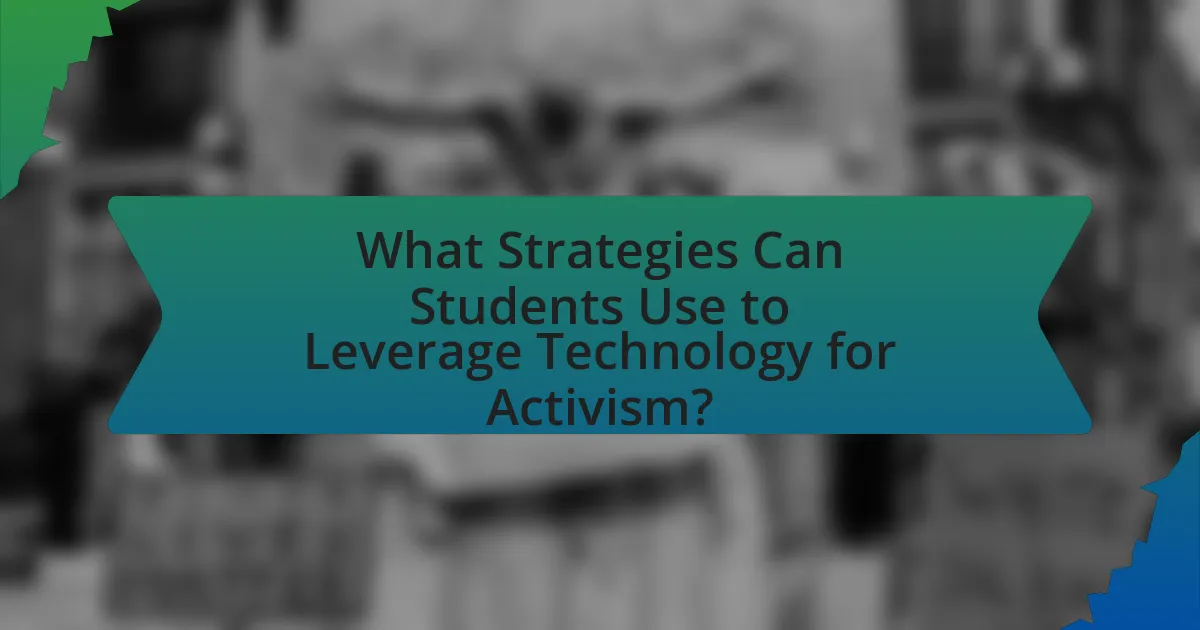
What Strategies Can Students Use to Leverage Technology for Activism?
Students can leverage technology for activism by utilizing social media platforms, creating online petitions, and engaging in digital storytelling. Social media platforms like Twitter and Instagram allow students to raise awareness and mobilize support quickly, as evidenced by movements such as #BlackLivesMatter, which gained traction through viral posts and hashtags. Online petitions on sites like Change.org enable students to gather signatures and demonstrate public support for causes, effectively influencing decision-makers. Additionally, digital storytelling through blogs, videos, and podcasts allows students to share personal narratives and experiences, fostering empathy and understanding around social issues. These strategies collectively enhance visibility and engagement in activism efforts.
How can students effectively use social media for activism?
Students can effectively use social media for activism by creating awareness, mobilizing support, and fostering community engagement. By sharing informative content, such as articles, videos, and infographics, students can educate their peers about social issues. For instance, the #BlackLivesMatter movement gained traction through social media platforms, where students shared personal stories and organized protests, demonstrating the power of collective action. Additionally, students can utilize hashtags to amplify their messages and connect with broader movements, as seen with the #MeToo campaign, which highlighted sexual harassment and assault. Engaging with followers through interactive content, such as polls and live discussions, further enhances community involvement and encourages dialogue around important topics.
What are best practices for creating impactful social media campaigns?
Best practices for creating impactful social media campaigns include defining clear objectives, understanding the target audience, and utilizing engaging content formats. Clear objectives guide the campaign’s direction, ensuring that all efforts align with desired outcomes, such as increasing awareness or driving engagement. Understanding the target audience allows for tailored messaging that resonates, increasing the likelihood of interaction. Engaging content formats, such as videos, infographics, and interactive posts, capture attention and encourage sharing, which is crucial for expanding reach. According to a study by HubSpot, campaigns that incorporate visual content receive 94% more views than those without, highlighting the importance of engaging formats in driving impact.
How can students measure the success of their social media activism?
Students can measure the success of their social media activism by analyzing engagement metrics such as likes, shares, comments, and follower growth. These metrics provide quantitative data that reflects the reach and impact of their campaigns. For instance, a study by the Pew Research Center found that social media campaigns with higher engagement rates are more likely to influence public opinion and drive real-world action. Additionally, tracking the number of participants in events or initiatives promoted through social media can further indicate the effectiveness of their activism efforts.
What role do online petitions and crowdfunding play in student activism?
Online petitions and crowdfunding serve as crucial tools in student activism by facilitating collective action and financial support for causes. Online petitions enable students to mobilize support quickly, allowing them to gather signatures and demonstrate widespread backing for issues such as tuition hikes or campus policies. For instance, a petition on Change.org can amass thousands of signatures in a short period, amplifying the voices of students and pressuring institutions to respond.
Crowdfunding platforms like GoFundMe empower students to raise funds for initiatives, events, or legal battles, making it easier to finance projects that might otherwise lack institutional support. A notable example is the 2018 crowdfunding campaign by students at Marjory Stoneman Douglas High School, which raised over $3 million for gun control advocacy. This financial backing not only sustains activism efforts but also enhances their visibility and impact.
Together, online petitions and crowdfunding create a dynamic ecosystem that fosters engagement, resource mobilization, and community building among students, ultimately driving social change.
How can students create and promote online petitions effectively?
Students can create and promote online petitions effectively by utilizing user-friendly platforms like Change.org or GoPetition, which allow for easy petition setup and sharing. To maximize impact, students should clearly define the issue, articulate specific goals, and use compelling language to engage potential signers. Promoting the petition through social media channels, email lists, and campus organizations can significantly increase visibility and support. Research indicates that petitions with a clear narrative and emotional appeal tend to attract more signatures, as evidenced by a study from the University of California, which found that emotionally charged campaigns can increase engagement by up to 30%.
What are the best platforms for crowdfunding student activism initiatives?
The best platforms for crowdfunding student activism initiatives are GoFundMe, Kickstarter, and Indiegogo. GoFundMe is widely recognized for personal and social causes, allowing students to raise funds for activism projects without platform fees. Kickstarter focuses on creative projects and requires a clear funding goal, making it suitable for innovative student initiatives. Indiegogo offers flexible funding options, enabling students to keep funds raised even if they do not meet their goal, which can be beneficial for ongoing activism efforts. These platforms have successfully facilitated numerous student-led campaigns, demonstrating their effectiveness in mobilizing financial support for activism.
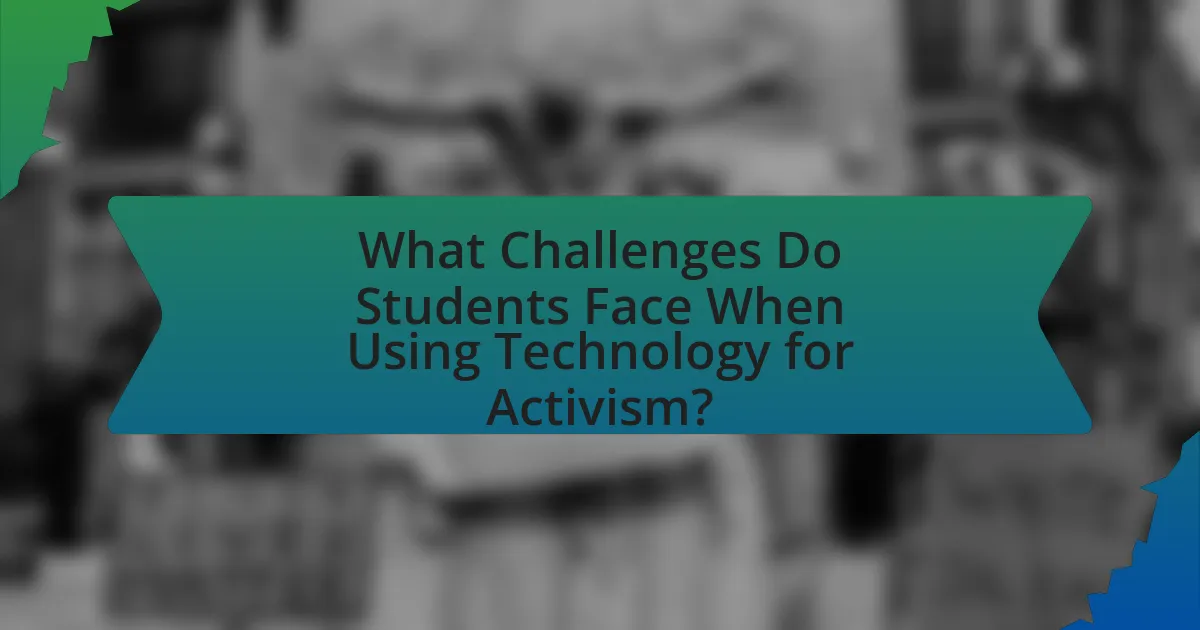
What Challenges Do Students Face When Using Technology for Activism?
Students face several challenges when using technology for activism, including digital divide issues, misinformation, and online harassment. The digital divide refers to the gap between those who have easy access to digital technology and those who do not, which can hinder participation in online activism. According to a 2021 Pew Research Center study, 25% of teens from lower-income families reported not having access to a computer at home, limiting their ability to engage in digital activism. Misinformation is another significant challenge, as students may struggle to discern credible sources from unreliable ones, leading to the spread of false narratives. Additionally, online harassment can deter students from participating in activism, with a 2020 report from the Anti-Defamation League indicating that 36% of young people experienced harassment online, which can create a hostile environment for activism. These challenges collectively impact the effectiveness of student-led initiatives in the digital space.
What are the potential risks of using technology in student activism?
The potential risks of using technology in student activism include privacy violations, misinformation, and digital surveillance. Privacy violations occur when personal data is shared or exposed through online platforms, potentially leading to harassment or targeting of activists. Misinformation can spread rapidly on social media, undermining the credibility of movements and causing confusion among supporters. Digital surveillance by authorities can lead to tracking and monitoring of activists, which may deter participation and create a chilling effect on free expression. These risks highlight the need for careful consideration of technology’s role in activism.
How can students protect their privacy while engaging in activism online?
Students can protect their privacy while engaging in activism online by using strong passwords, enabling two-factor authentication, and utilizing privacy-focused platforms. Strong passwords reduce the risk of unauthorized access, while two-factor authentication adds an extra layer of security, making it harder for attackers to compromise accounts. Privacy-focused platforms, such as Signal for messaging or ProtonMail for email, offer end-to-end encryption, ensuring that communications remain confidential. According to a 2021 report by the Electronic Frontier Foundation, using these security measures significantly decreases the likelihood of personal data breaches, thereby enhancing online privacy for activists.
What measures can be taken to combat misinformation in student activism?
To combat misinformation in student activism, implementing digital literacy programs is essential. These programs educate students on identifying credible sources, fact-checking information, and understanding the impact of misinformation. Research indicates that students who receive training in digital literacy are better equipped to discern reliable information from false claims, thereby reducing the spread of misinformation. For instance, a study by the Stanford History Education Group found that students often struggle to evaluate online information, highlighting the need for structured educational interventions. Additionally, fostering a culture of transparency and open dialogue within activist groups can further mitigate misinformation by encouraging members to share verified information and discuss concerns openly.
How can students overcome technological barriers in activism?
Students can overcome technological barriers in activism by utilizing accessible platforms and resources to enhance their outreach and engagement. For instance, students can leverage social media tools like Twitter and Instagram, which have proven effective for mobilizing support and disseminating information quickly, as evidenced by the widespread use of these platforms during movements such as Black Lives Matter. Additionally, students can participate in workshops or online courses that focus on digital literacy and cybersecurity, which are essential for navigating the online landscape safely and effectively. Research indicates that 70% of young activists report using social media as their primary tool for organizing, highlighting its importance in modern activism. By embracing these strategies, students can effectively navigate and mitigate technological challenges in their activism efforts.
What resources are available for students lacking technological skills?
Students lacking technological skills can access various resources, including community workshops, online tutorials, and school support services. Community centers often offer free or low-cost workshops that teach basic computer skills, while platforms like Khan Academy and Coursera provide online courses tailored to beginners. Additionally, many educational institutions have dedicated staff or tutoring programs to assist students in developing their technological competencies. These resources are essential for empowering students to engage effectively in digital activism and utilize technology in their advocacy efforts.
How can students collaborate to share technological resources and knowledge?
Students can collaborate to share technological resources and knowledge by utilizing online platforms and tools designed for communication and resource sharing. For instance, platforms like Google Drive and Dropbox enable students to store and share documents, while communication tools such as Slack or Discord facilitate real-time discussions and knowledge exchange. Research indicates that collaborative learning environments enhance student engagement and knowledge retention, as seen in studies conducted by the University of California, which found that peer collaboration significantly improves learning outcomes. By actively participating in these platforms, students can effectively pool their technological resources and expertise, fostering a collaborative atmosphere that supports their activism efforts.
What are some practical tips for effective student activism using technology?
Effective student activism using technology can be achieved through strategic social media engagement, online petitions, and virtual organizing. Social media platforms like Twitter and Instagram allow students to amplify their messages, mobilize supporters, and create awareness about issues quickly. For instance, the #BlackLivesMatter movement utilized Twitter to spread information and organize protests, demonstrating the power of social media in activism.
Additionally, online petitions on platforms such as Change.org enable students to gather signatures and demonstrate public support for their causes, making it easier to present demands to decision-makers. Virtual organizing tools like Zoom facilitate meetings and discussions, allowing students to collaborate regardless of geographical barriers.
These methods have proven effective in recent campaigns, where technology has played a crucial role in mobilizing large groups and influencing policy changes.
How can students create a sustainable online presence for their activism?
Students can create a sustainable online presence for their activism by consistently engaging with their audience through authentic content and utilizing various digital platforms effectively. This involves regularly posting updates, sharing informative resources, and interacting with followers to build a community around their cause. Research indicates that consistent engagement can increase follower loyalty and participation; for instance, a study by the Pew Research Center found that 69% of adults use social media, making it a powerful tool for outreach. Additionally, students should leverage analytics tools to track engagement metrics, allowing them to refine their strategies based on what resonates with their audience. By maintaining a clear and focused message, students can ensure their activism remains relevant and impactful over time.
What tools can students use to organize and mobilize effectively?
Students can use digital platforms such as Trello, Slack, and Google Drive to organize and mobilize effectively. Trello allows students to create boards for project management, facilitating task assignments and deadlines, which enhances collaboration. Slack serves as a communication tool that enables real-time messaging and file sharing among group members, streamlining discussions and updates. Google Drive provides cloud storage for documents and collaborative editing, ensuring that all members have access to necessary resources. These tools collectively improve organization and coordination, making student activism more efficient and impactful.
